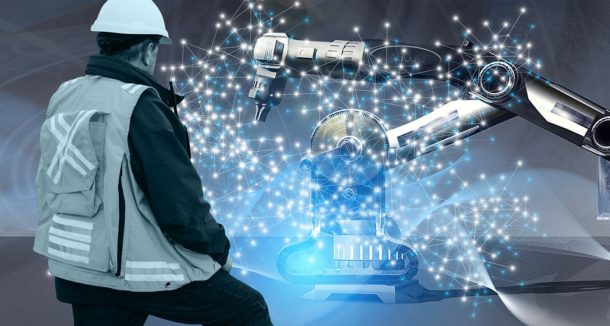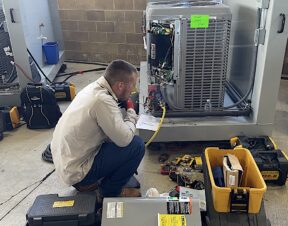The rapid development of computing and digital technology has dramatically accelerated the development of Artificial Intelligence. This industry is very young, so all significant discoveries are still to come. However, in this article, you can find several important achievements in modern manufacturing even today.
The World of Artificial Intelligence
Artificial Intelligence is the ability of technical tools to perform creative functions traditionally considered humans’ prerogative. It goes to speech recognition and understanding, solving engineering problems, tracking situations, making decisions based on identified changes, and other intelligent functions. It’s the next, noticeably higher stage of automation development.
Traditional controllers and mechanisms operate on simple logic: they form a specific control action when any parameter changes. However, AI technologies allow considering hundreds and thousands of factors, generating many solutions, and choosing the most effective ones. And here, the skill to “choose” is of particular importance. Indeed, you can solve the same problem in different ways.

For example, there’re three options for reducing the supply airflow rate in a particular facility:
- Сreate additional resistance in the network by partially closing the control valve.
- Reduce the speed of the fan.
- Open the parallel control valve so that the flow rate in the alternate direction is increased and the flow rate in the desired order is reduced.
The first method seems to be the simplest. But it’s also the least efficient since it increases the system’s energy consumption. It decreases in the second and third options, but there will be a risk of unbalancing. And here, the fourth solution is also possible. It would be a combination of the three proposed above: reduce the fan speed and adjust both dampers so that all facilities get the right amount of air.
And if you want to learn more about each of the ways, you can order a paper from Rated by Students, which will save you from searching for information on your own. Hardly any service technician would risk such a solution because it would take more than one working day to solve the problem.
But with an intelligent controller and all the necessary actuators, he can meet the challenge instantly. So, AI operates with large amounts of data, knows how to solve problems by different methods, evaluates the efficiency of each of them, and chooses the best option.
A Few Simple Examples of AI
Infrared sensors that detect a person’s location in a room for optimal temperature control and airflow direction can be considered a successful example of artificial intelligence. Air conditioners with such functions track the motion and activity of a person. The compressor rotations are reduced if the sensors do not observe movements during a specific period.
Moreover, if a person sleeps, the conditioner switches to energy-saving mode. And if there’s nobody in the room, it turns off. Besides, optimizing an operating way in the nighttime is possible when the heat is much lower. These innovations save up to 20% of electricity consumed by the air conditioner.
If you want to learn even more about other innovations, check out Top Writing Reviews to keep up with the latest developments related to AI. For example, similar sensors can be integrated into the ventilation system. Then it can automatically switch off if a person has left the object and switch on when a person comes back.
If a person goes to one room and enters another, the system will continue to ventilate both. Likewise, when a person has left the building, the ventilation system will continue to work as if nothing had happened. So AI eliminates such inefficiencies due to motion, infrared, and carbon dioxide sensors.
AI in Ventilation and Air Conditioning Systems
The calculation of ventilation and air conditioning systems is usually made for each room separately. But in practice, the objects practically never work in the design mode. It’s because all company employees have the right to leave, on average, one month a year. To be more precise, 28 days out of approximately 250 working days. It means that at least 11% of the time of the year, a person is not in the workplace.
Considering sick days, business trips, meetings, telecommuting, and other factors, the average length of time a person stays at work is no more than 70% of the time. So the remaining 30% of the time the climate systems work for that person is wasted. In addition, rooms at the facility can be working and auxiliary. Workrooms include offices, cabinets, the lobby with a reception desk, and others.
Nowadays, ventilation and air conditioning systems are calculated to assume that people use all these rooms to the maximum. If a person works in his office, it’s evident that he is not in the meeting room or kitchen at that moment. But the building’s engineering systems are not aware of this.
In the case of air conditioning systems, the operation of indoor and outdoor units is adjusted. In the absence of people, the indoor units go into economy mode and shut down after a while. However, when people appear, the operation of the air conditioning system resumes.
Use of Night Cooling
The higher the outdoor temperature, the higher the air conditioner’s energy consumption. However, the outdoor air temperature varies significantly during the day: it’s lower at night and higher during the day. Thus the most significant load on the premises appears during the daytime when air conditioning systems work with the least efficiency.
The device of cold accumulators can help increase the efficiency of air conditioners working in the daytime. In the most straightforward configuration, such a system is a chiller or outdoor unit of a freon system with a water-cooled condenser and a water circuit, including an outdoor storage tank and a driver. Coldwater from the tank is used to cool the condenser, and if it’s insufficient, water cooling is initiated by the dry cooler.
Water from the storage tank can also be used to cool the supply air, providing a tangible benefit. For example, during the day, the air cooler of the air handling unit cools the air from +28 to +22°C, which is 6°C. If the outdoor air has cooled the water at night to +20°C, the system can handle all the heat gain. In other situations, water will help cool the air to 23-24°C, saving 60 to 90% of the chiller’s power consumption.
AI at the Building Level
Many engineering systems function simultaneously in every building. So their mutual coordination and efficient operation require special attention. As a rule, serious problems arise when systems with opposite purposes operate (air conditioning and heating). In practice, there are situations when the effect of one system is neutralized by the other.
It causes double energy losses and a significant decrease in the energy efficiency of the object. Needless to say that the increased intensity of the heating system requires additional costs, and the work of air conditioners only increases them. Thus, it’s evident that a computer analysis of the situation would not allow such a waste of resources.
Conclusion
The widespread use of various sensors to control engineering systems will significantly reduce the energy consumption of ventilation and air conditioning systems. The next task here is to create a self-learning building management system. And the work in this direction is already underway. Thus, self-training algorithms have been created to recognize faces, images, speech, and handwriting. We should expect the introduction of similar algorithms in the engineering and manufacturing industry soon, with the prospect of a fully automatic system.
 Lafond Wanda is a professional content writer, copywriter, content strategist, and communications consultant. She started young with her writing career from being a high school writer to a university editor, and now she is a writer in professional writing platforms— her years of expertise have honed her skills to create compelling and results-driven content every single time.
Lafond Wanda is a professional content writer, copywriter, content strategist, and communications consultant. She started young with her writing career from being a high school writer to a university editor, and now she is a writer in professional writing platforms— her years of expertise have honed her skills to create compelling and results-driven content every single time.




Join the conversation: